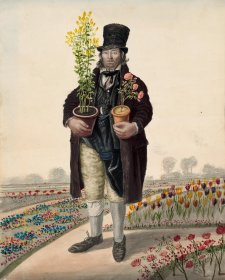The 18th century saw British military forces engaged in the Jacobite rebellion and in imperial conflicts in India and North America, while European treaties and opportunism also meant involvement in several Continental wars, including the War of the Austrian Succession and the Seven Years’ War. It was the two decades of almost continuous war with France (initially against the Republic and, after 1804, against Napoleon), however, that was to have the greatest impact on British society at large. Over the course of the war, the number of men serving in the army and navy combined rose from fewer than 100,000 to almost half a million, and most of this largely volunteer force was demobilised after Waterloo.
Not surprisingly, over the ensuing couple of decades the ‘old soldier’ becomes a common trope in British art and literature and politics, envisioned variously as heroic, pathetic or even threatening. In the 1820s, the image finds its most remarkable and popular manifestation in David Wilkie’s The Chelsea pensioners receiving the London Gazette Extraordinary of Thursday June 22d., 1815, announcing the Battle of Waterloo!!! (1822, Apsley House, London), with its rich array of uniforms and ages and, by association, regiments and campaigns (many particularly specified in the work’s description in the 1822 Royal Academy catalogue), and with its servicemen and veterans all evidently well-pleased, well-fed, well-clothed and even well-lubricated.
The reality was, of course, very different. Not only were many old soldiers and sailors severely disabled from wounds, like Dempsey’s Salisbury amputee, but with the contracting postwar economy unable to absorb the sudden influx of surplus labour, even able-bodied former military and naval personnel found themselves without employment. Some veterans managed to cobble together a precarious existence after the wars, as the careers and memoirs of James Guidney and David Love attest. However, many remained dependent on charity. At the start of the war with France in 1793, there were 20,594 military out-pensioners.
By 1816, the year after Waterloo, this figure had almost doubled, to 39,217 and, with subsequent further demobilisations and reduction of the standing army, it had more than re-doubled by 1828, to 85,834. Others fell back on parish relief; Dempsey’s unnamed old soldier at the market town of Hadleigh in Suffolk would seem to fall into this category.
Thomas Edwards, the Winchester old sailor, is a slightly different case. Aged 95 at the time of his portrait, Edwards was celebrated as much for his longevity as for his naval career; his service may have dated from as far back as the War of Jenkins’ Ear in the 1740s. It was this great age that earned Edwards the attention of the artist, and the dignity of an obituary in the Hampshire Chronicle when he died two years later.
Collection: Tasmanian Museum and Art Gallery, presented by C. Docker, 1956



Dempsey’s people: a folio of British street portraits 1824–1844 is the first exhibition to showcase the compelling watercolour images of English street people made by the itinerant English painter John Dempsey throughout the first half of the nineteenth century.



Visit us, learn with us, support us or work with us! Here’s a range of information about planning your visit, our history and more!



We depend on your support to keep creating our programs, exhibitions, publications and building the amazing portrait collection!